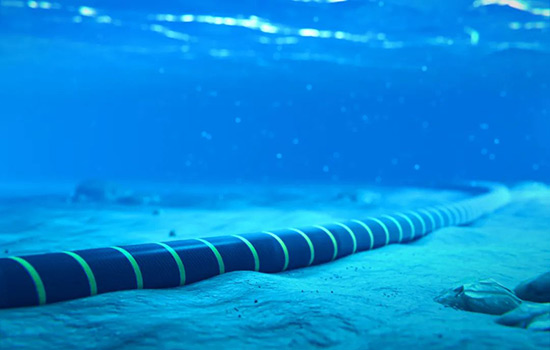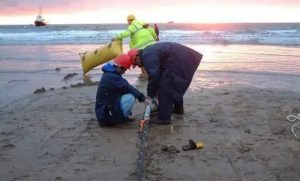Submarine cables engineering is recognized worldwide as a difficult and complex large-scale technical project.
Both the cable design, manufacturing, and laying construction are much higher than other general cable products.
Among them, are the intermediate joints of submarine cable, the production of terminals, installation, and wiring. And test commissioning is also a very important part of this complex technical engineering.
Its production, and installation quality are good or bad, and the safety and reliability of the entire transmission and substation play a very important role.
Submarine cable is what
Submarine cable is laid in rivers, lakes, and seas underwater power cable, also known as underwater cable.
It is compared with land-based cables, there is little difference in the main insulation.
Due to the special construction methods and operating conditions of submarine cables, in the armor, metal jacket, manufacturing length. And other structural aspects of the larger differences.
Submarine cables are often manufactured into large lengths of whole cables, which need to be coiled into circles for transportation.

Although the armor with short pitch can reduce the coiling diameter. The submarine cable with short-pitch armor is easy to be knotted underwater when it is under large tension in the laying process.
Therefore, the general armor pitch needs 12–14 times the average diameter of the armor.
To reduce the coiling diameter, some use short-pitch pre-stressed steel wire or double steel wire armor, and some use armor with the opposite direction of the inner and outer twist.
What are the types of submarine cables?
Structure-wise
Mainly divided into three-core submarine cable and single-core submarine cable, low- and medium-voltage lines using a three-core submarine cable. And high-voltage lines using a single-core submarine cable.
In terms of function
Half a century ago, the submarine cable is only a simple electrical energy transmission function.
Now the submarine cable integrates two functions, effectively realizing the transmission of electrical energy and signals on the same cable.
From the insulation composition
There are oil-filled insulated submarine cables and extruded plastic insulated submarine cables.
About the load type
There are DC and AC cables.
DC submarine cable is characterized by low-loss, easy-to-achieve long-distance power transmission.
However, the application experience of DC submarine cable is not rich. And the supporting construction costs of converter stations and others are high.
AC submarine cable loss is large, but the operation and maintenance technology is mature, supporting the small construction costs.
Therefore, submarine cable line designers usually have to make technical and economic trade-offs to maximize the benefits.
How to wire submarine cables
Submarine cables routing survey
The cable routing survey before the laying of submarine cables includes:
① Clean up the water depth, topography, and shallow stratigraphic profile measurement of the offshore routing area.
② Sediment surface sampling, column sampling, and static touch survey.
③ It also includes surveys of traffic and construction conditions and obstacles that reflect the status of marine development activities.
Recently, the use of advanced GPS post-processing positioning and (CPT) static touch technology has led to a significant increase in survey speed and effectiveness.
Submarine cable laying
The submarine cable laying project is recognized as a complex and difficult large-scale project by countries all over the world.
The cable laying should control the angle of the cable into the water and the laying tension by controlling the sailing speed of the laying vessel and the cable release speed to avoid damaging the cable due to too small a bending radius or too much tension.
In shallow seas, such as water depth of fewer than 200 meters in the sea, the cable is buried.
In the deep sea, the cable is laid, and the cable is released by the cable-laying vessel. And the cable is constantly monitored and adjusted using underwater monitors and underwater remote control vehicles.
Also, control the forward speed and direction of the laying ship and the speed of laying the cable to avoid damaging the cable by bypassing uneven places and rocks.
Flush burial protection of submarine cables
In the final stage of construction, the main purpose is to protect the submarine cable by deep burial to reduce the impact of the complex marine environment on the submarine cable and ensure operational safety.
In the sandy and silty area, a trench about 2 meters deep is generated by high-pressure flushing water to bury the cable into it, and the sandy soil next to it covers it.
For coral reef and clay areas, cut a trench 0.6 – 1.2 meters deep with a cutter, bury the cable into the trench and backfill it naturally to form protection.
In hard rock areas, the cable needs to be covered with a cement cover and other hard objects to implement protection.

How to waterproof the underwater cable line
It is a wire wrapped with insulating material to isolate water from the cable, thus providing a waterproof function.
The cable is made in such a way that the cable is first embedded in a jelly-like compound that protects the cable from damage even in the event of contact with seawater.
The fiber optic cable is then packed into a steel tube to prevent the pressure of water from damaging it.
Next, it is wrapped in an overall very strong steel wire and snapped into a copper tube, and finally, a protective layer of polyethylene material is applied.
Near the coast of the continental shelf, submarine cables are usually laid with lighter cables with stronger steel wires and covered with an asphalt coating to prevent corrosion by seawater.
Submarine cable how to anti-corrosion
Submarine fiber optic cables are highly susceptible to seawater corrosion because they are immersed in highly concentrated seawater for long periods.
In addition, hydrogen molecules can diffuse into the glass material of the fiber, making the loss of the fiber larger.
Therefore, submarine fiber optic cables need to prevent both the internal generation of hydrogen and the infiltration of hydrogen into the fiber optic cable from the outside.
Currently, submarine fiber optic cables are constructed by spirally wrapping the once or twice-coated optical fiber around the center and reinforcing members around it.
The above is an introduction to submarine cables. If you have any questions about cable purchase, welcome to like ZMS cable.